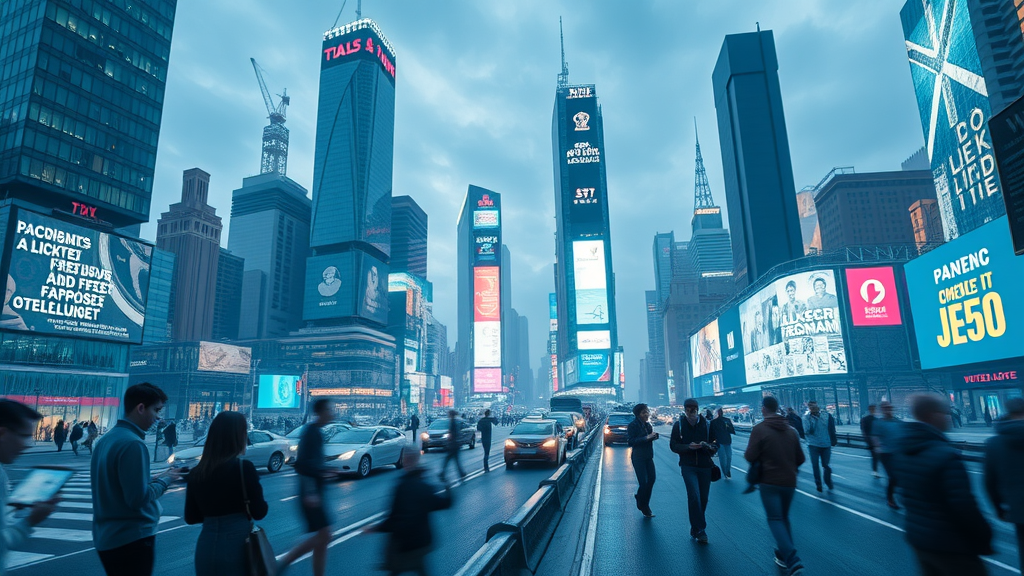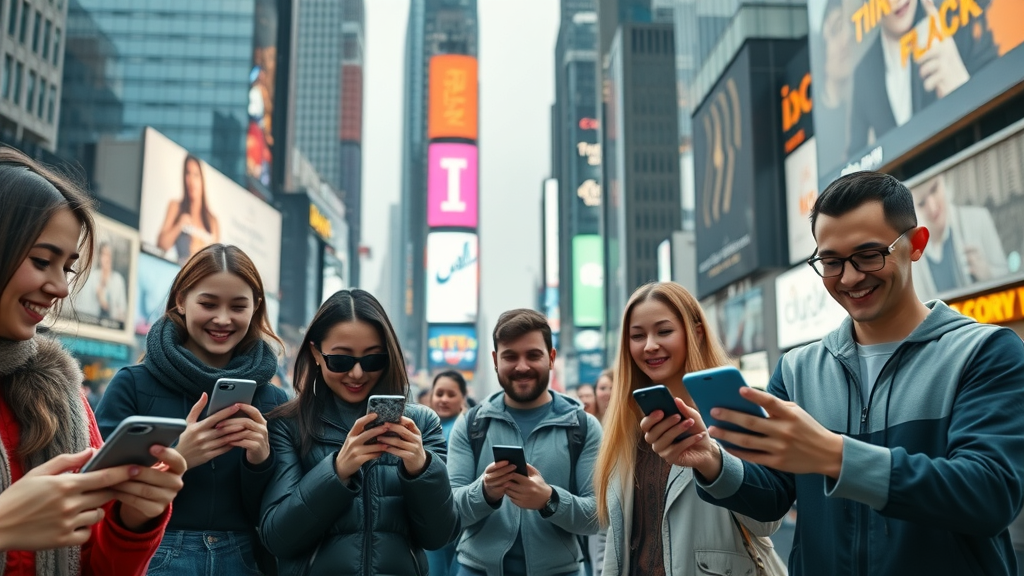Here’s an astonishing fact : By the end of 2025, more than 65% of all digital content we consume will be created or enhanced by artificial intelligence. As digital media channels 2025 speed toward the future, shifts in social media, marketing channels, and digital experiences are happening at an unprecedented rate—leaving only the agile and the informed ahead of the curve.
If you want to lead in digital marketing and business, you can’t afford to overlook the rapid changes in digital media channels. This article breaks down the most important trends, platform shifts, and actionable strategies for thriving in 2025. Ready to see what’s changing and how to win big?

Surprising Shifts in Digital Media Channels 2025: An Unconventional Look at Rapid-Fire Change
As we approach digital media channels 2025, the landscape is transforming in ways few predicted. Platforms are no longer merely places for social interaction—they’re bustling digital markets, AI-driven hubs, and immersive experiences. One striking statistic sets the tone: AI-generated content is expected to make up over 65% of digital consumption by the end of the year. This shift is not just about technology—it’s about how consumers connect with brands, discover new ideas, and make purchasing decisions.
Digital marketing strategies are evolving rapidly alongside these trends. Marketers now have to balance content creation speed, hyper-personalization, and privacy—all while navigating new regulations and consumer demands. Media trends are moving away from siloed approaches to truly integrated digital marketing ecosystems that mix search engines, social channels, and emerging platforms. As business leaders and content creators navigate these changes, it’s clear that adapting quickly is necessary to keep up.
Explore the Impactful Transformation of Digital Media Channels 2025 Through a Striking Statistic
Imagine this: In just one year, platform-driven video content consumption has surged by 80%, thanks to the rise of short-form videos and live streaming. This isn’t just a shift in entertainment—it’s a sea change for how brands reach their target audience and boost brand awareness. Social media users now interact with content on 4-5 different channels daily, further blurring the lines between digital channels.
The average media user in 2025 is more digitally savvy, demands immediate engagement, and expects transparency from brands. Digital market leaders are leveraging AI tools to provide content that adapts in real time, and smart marketing channels must diversify across social platforms, search engines, and beyond. These numbers reflect not only where the industry stands but also where it’s heading.
- AI-driven content will dominate digital platforms, reshaping authenticity and speed.
- Omnichannel marketing strategies will replace single-channel campaigns for deeper reach.
- Interactive and immersive experiences, such as AR-powered advertising, are rising rapidly.
- Privacy-first approaches and ethical data usage are at the forefront of consumer demands.
- Emerging regions, such as the Middle East, are becoming digital powerhouses.
Why Digital Media Channels 2025 Demand Attention: Core Concepts, Search Intent, and Consumer Behaviors

To stay ahead in the world of digital media channels 2025 , understanding core concepts is a must. These aren’t just technical details; they’re powerful shifts in how media users search for content, interact with marketing channels , and define their online identities. Every click, swipe, or tap is informed by new platforms, smarter algorithms, and greater demand for privacy. Your business goals depend on mastering these changing behaviors.
Consumer search intent is now more complex. People expect brands to anticipate their needs across digital channels, whether using a search engine, scrolling a social media platform, or viewing a targeted ad. Digital marketing must deliver fluid, relevant, and timely messaging—not just blanket ad spend. As attention spans shrink and privacy concerns rise, those who can align with these shifts will be the ones to capture new opportunities.
Aligning ‘Digital Media Channels 2025’ With Modern Marketing Channel Strategies
Today’s modern marketing strategy is built on integrating digital media channels 2025 into every touchpoint. It’s no longer enough to focus on one social platform or rely solely on website-based content. Marketers need agile systems to engage via mobile apps, virtual communities, and AI-powered chatbots. With each channel working together, brand awareness is amplified and the customer journey is connected.
The most successful marketing channels are leveraging AI tools for data segmentation and enhanced personalization. Understanding the demographics (such as age group or location) and fine-tuning message frequency are central to these strategies. Marketers using a multi-channel approach—combining social channels, digital platforms, and search engine strategies—are set to achieve more results with less wasted spend.
Evolving Role of Digital Market and Digital Marketing in Media Trends
The digital market has expanded beyond traditional boundaries, creating new roles for digital marketing. While media trends used to hinge on influencer marketing and viral campaigns alone, today’s winning formula involves a blend of generative AI , interactive media, and customer-centric platform design. The media user of 2025 expects innovative experiences—ones that can adapt to their behaviors and preferences instantly.
As AI-generated content accelerates, marketers must rethink how they use digital marketing to stay authentic and build trust. Transparency in ad spend, ethics in data collection, and real-time responsiveness define tomorrow’s most effective marketing strategies.
Major Media Trends Shaping Digital Media Channels 2025

Every year, new media trends emerge to challenge the status quo. In 2025, the trends leading the pack are deeper integration of social media platforms , an increased reliance on generative AI for generated content , and a surge in omnichannel strategy adoption. Media platforms now offer tools that enable marketers to analyze, adapt, and diversify faster than ever—ensuring campaigns remain both relevant and effective.
It’s not just technology that’s changed. The ways users participate, collaborate, and buy have fundamentally shifted. Today’s marketing channels are measured not only by reach or impressions but also by how well they can foster conversation, trust, and community engagement.
Rise of Social Media Platforms and Diversification in Social Platform Usage

Over the past few years, social media platforms have exploded in both number and functionality. Social media users now switch between video-sharing apps, live-stream forums, and niche community-focused platforms—each fulfilling slightly different needs. This diversification means marketers have to tailor brand messaging, leverage micro-influencers, and make use of each platform’s unique features.
Consumer behavior is more nuanced across social platforms in 2025. Each social channel offers its own culture and best practices. Businesses that succeed are those who can integrate seamlessly, speak the language of each platform, and provide interactive experiences that keep the target audience coming back for more.
Marketing Channel Innovations: From Multi-Channel to Omnichannel Approaches
The traditional multi-channel approach—where separate campaigns run on various digital platforms—has evolved into true omnichannel marketing. This innovation allows for real-time, synchronized brand engagement across all social media, digital channels, and even offline touchpoints, creating a unified customer journey regardless of entry point.
AI tools now power dynamic content generation, automate scheduling, and deliver real-time audience feedback to optimize every marketing channel. Marketers can see instantly which content, ad, or influencer is driving engagement, allowing for agile pivots and more precise messaging.
Generative AI and Generated Content: The Next Frontier for Digital Media Channels 2025
“By the end of 2025, over 65% of consumed digital content will be generated or enhanced by artificial intelligence.”
Generative AI is not just a futuristic buzzword—it’s now the backbone of digital media channels 2025 . From automated video and written content creation to sophisticated chatbots, these AI-powered solutions are transforming how quickly and creatively brands can engage with media users. As a result, AI-driven personalized recommendations, smart advertising placements, and even augmented reality experiences are more accessible than ever.
The race toward more efficient, authentic, and generated content is on. Marketers who embrace generative AI will tap into superior content speed, reach, and adaptability, while those who resist risk falling behind rapidly changing media trends.
How Social Media and Social Platforms Revolutionize Digital Media Channels 2025
Few forces have shaped digital media channels 2025 like the explosive evolution of social media . These platforms aren’t just places to connect—they’re crucial engines for commerce, influence, and immediate interaction. Social media users have become creators, curators, and critics all at once, driving new expectations of authenticity and real-time engagement from brands.
Social platforms now serve as hubs for community-driven content, where conversations happen around the clock and audiences splinter into ever-more defined micro-communities. Businesses that ignore these shifting communities risk missing out on the true pulse of modern marketing.
Social Media in 2025: New Features, Rules, and Audiences

The social media platforms of 2025 are more than ever governed by new rules (and even laws) around data privacy and transparency. As regulations grow, so too do platform features—ranging from advanced moderation tools to AI-driven content suggestion engines. For brands, keeping up with these rapid updates is essential.
Today’s social media users expect user-friendly privacy controls, tighter community standards, and interactive experiences. Marketers must now adapt their content to appeal to audiences who value authenticity, creative storytelling, and rapid, reactive engagement.
Social Platform Convergence and Community-Driven Content in Digital Marketing
One of the most notable media trends is the convergence of social platforms . As user needs shift, once-distinct platforms now share features, integrating short-form video, live streaming, e-commerce, and interactive communities. Community-driven content informs marketing strategies—successful brands encourage customers to create, react, and tell their own stories.
This participatory shift means digital marketing campaigns must build relationships over time, with brands investing in long-form storytelling, interactive polls, and collaborative experiences—creating conversations that keep people coming back.
Marketing Channels in Digital Media Channels 2025: What’s Evolving Fast?
The pace of change in marketing channels is unprecedented. Search engine strategies, AI-driven ad targeting, and automated personalization shape every touchpoint, whether on a social media app or a commerce site. No longer is there a one-size-fits-all approach—each business must craft its own combination of marketing channels based on its target audience and business goals.
Data-driven marketers integrate old and new platforms, harnessing smart analytics to make every ad spend dollar count. As digital market boundaries dissolve, agility is now the single most important trait for success.
Marketing Strategy Shifts: Leveraging New Digital Market Opportunities

With new digital market frontiers opening up, businesses have to strategize smarter than ever. Adaptive marketing strategies combine AI insights, diverse content, and geo-targeted campaigns. A brand’s marketing strategy is now expected to flex in real time, making quick pivots based on live analytics, shifting audience tastes, and even global news cycles.
Data from social channels, customer feedback, and audience interactions feed into campaign refinements, ensuring media platforms are always relevant, always timely, and always influential.
Cross-Platform Integration: Blending Social Media, Search Engine, and Emerging Platforms
2025 is the year of true cross-platform integration. Brands now blend social media, search engine, and emerging platforms into seamless campaigns delivering unified experiences—no matter where, when, or how users connect. This not only increases brand awareness, but also maximizes every interaction for both acquisition and loyalty-building.
Search engines continue to serve as gateways, but with added emphasis on discoverability via metasearch, social signals, and even influencer rankings. As digital channels intertwine, marketers who can synchronize their presence—using every relevant network—will command the most attention in the digital market.
Geographic and Demographic Evolution: The Middle East & Beyond In Digital Media Channels 2025
Global growth in digital media channels 2025 is not distributed evenly—new regions like the Middle East are quickly becoming digital powerhouses. From increased ad spend to rising numbers of social media users, these areas set trends rather than follow them. Understanding regional variations and demographic shifts is critical for scaling your business in new markets.
Every age group now uses multiple platforms, and new media users demand ultra-personalized experiences. Targeted campaigns require localized messaging, diverse content formats, and a keen sense of cultural nuance.
Digital Market Expansion in the Middle East and Other Growth Regions

The Middle East is on pace to surpass previous records with its surging digital market and young, connected populations. With the highest rates of mobile and social adoption, marketers find untapped opportunities to lead in platform innovation, influencer marketing, and AI-powered personalization. Partnerships with local creators and investment in regional campaigns are becoming must-have tactics.
Beyond the Middle East, India, Southeast Asia, and parts of South America are also setting the pace for new platform adoption, diverse content types, and rapid increases in online commerce—all key for international marketing channels in 2025.
Audience Targeting: Harnessing Data for Precision Digital Marketing

Precision audience targeting has never been more sophisticated. Brands now tap vast pools of data to tailor messaging by age group, interest, location, and real-time behavior. AI tools make it easy to test and deploy dozens of content variations, each designed for specific segments.
The most successful marketing strategy employs live analytics, real-time feedback, automated audience segmentation, and smart retargeting, ensuring every digital marketing message is relevant and impactful.
Understanding the Digital Experience Trend in 2025 Across Digital Media Channels
- Personalization: Media users now expect brands to deliver content based on their preferences, location, and real-time interests.
- Privacy: Stronger privacy controls and data transparency are table stakes for building trust across any digital channel.
- Trust: Brands must be consistently authentic and uphold ethical data use to retain audience loyalty.
- Interactivity: Interactive content—live polls, AR overlays, and instant feedback—drives higher engagement across all platforms.

Delivering an exceptional digital experience goes beyond good design or speedy websites. Brands must orchestrate every touchpoint—across social media platforms, search engines, and digital platforms—to be instantly relevant and frictionless. In 2025, the digital experience is measured by how effectively a brand can turn clicks into conversations, and conversations into customer loyalty.
Data privacy will remain a core concern, with users flocking to brands that not only offer opt-in personalization but also explain how their information is used. Interactive media—from AR shopping tools to live Q&As—keeps users engaged and coming back to discover more.
Emergence of Short-Form and Live Video on Social Platforms
Short-form and live video are dominating media trends in 2025. Platforms like TikTok, Instagram Reels, and live-stream commerce sites are prioritized by algorithms and audiences alike. More than 70% of all video content on social platforms is now watched in vertical format or consumed during live broadcasts.
For brands, this means shifting creative budgets toward micro-video, live Q&As, shoppable streams, and influencer collaborations—often in partnership with automated AI tools that help select the best-performing content formats. Engagement rates for short-form and live content are now two to three times higher than traditional video, setting the standard for future campaigns.
| Channel | Key Features | Pros | Cons |
|---|---|---|---|
| Social Media | Short-form video, live streaming, micro-communities, AR filters | High engagement, viral potential, rapid feedback | Algorithm fatigue, privacy concerns, short content lifespan |
| Digital Market | AI-powered recommendations, e-commerce integration, localization | Scalable personalization, global reach, detailed analytics | High competition, complex setup, requires trust-building |
| Search Engine | Featured snippets, voice search, AI-driven indexing | High discoverability, intent-based targeting, evergreen traffic | SEO complexity, slow initial results, competitive landscape |
People Also Ask About Digital Media Channels 2025
Will digital marketing grow in 2025?
Digital marketing is projected to see double-digit growth globally in 2025, fueled by expanding digital media channels, increased mobile connectivity, and the integration of AI-driven content and advertising solutions.
What is the future of digital media?
The future of digital media will be shaped by hyper-personalization, immersive interactive content experiences, widespread use of generative AI, and a pivot toward privacy-first platforms and ethical data usage.
What is the digital experience trend 2025?
The dominant digital experience trends for 2025 include advanced personalization, seamless omnichannel engagement, use of augmented reality, and automated AI customer interactions across digital media channels.
What will social media look like in 2025?
Social media in 2025 will be more decentralized, community-oriented, and feature rich, prioritizing privacy controls, immersive advertising, and real-time live content, largely powered by AI and automated moderation.
Expert Insights: Strategies to Succeed with Digital Media Channels 2025
- Assess your current digital presence and where your audiences interact most.
- Integrate generative AI tools and personalization engines into your content workflow.
- Adopt omnichannel strategies, ensuring consistency and relevance at every touchpoint.
- Invest in emerging regions and platform localization, especially in areas like the Middle East.
- Upgrade analytics and feedback loops for real-time performance optimization.
- Prioritize transparency, ethical data collection, and privacy-first policies to foster audience trust.
- Test and refine campaigns using live feedback and agile marketing frameworks.
Essential FAQs for Navigating Digital Media Channels 2025
How do I select the best digital media channels 2025 for my business?
Start by identifying the platforms and channels where your target audience is most active. Analyze demographic data, content preferences, and regional trends. Test several media platforms, monitor engagement, and continuously optimize based on performance and business goals in 2025.
What role will search engine optimization play in digital marketing 2025?
SEO will be crucial, but it’s shifting to include new formats like video, voice search, and AI-curated snippets. Search engine optimization must work alongside social platforms and digital channels, focusing on intent-based content, site speed, and immersive user experience.
How can I harness generative AI for content in digital media channels 2025?
Leverage generative AI tools to scale production of personalized, dynamic, and context-aware content across all digital platforms. Automate repetitive tasks, experiment with new formats, and use AI insights to refine campaigns for maximum relevance and impact on digital media channels 2025.
What are the critical risks and opportunities in media trends 2025?
Critical risks include data privacy issues, algorithm changes, and media fatigue. Key opportunities center on community engagement, generative AI, and expanding into new regions and niche platforms. Strategic adaptation allows brands to take advantage of fast-changing marketing channels and avoid common pitfalls.
Unified Strategy Recap: Integrating Digital Media Channels 2025 Into Your Marketing Channels
- Clearly map your omnichannel strategy across platforms and business units.
- Invest in continuous upskilling for your marketing team in AI, data, and emerging media platforms.
- Set measurable goals for each digital channel and monitor with real-time analytics.
- Emphasize interactive content, community management, and transparent data usage for differentiation.
Securing Your Spot Ahead: Take Action to Lead With Digital Media Channels 2025
Seize the change—embrace AI, invest in cross-platform agility, and let user experience lead. Act now, and ensure your brand stands out as a digital leader in 2025.
In the rapidly evolving landscape of digital media channels in 2025, several key trends are reshaping how brands engage with audiences. The rise of niche streaming platforms is particularly noteworthy, as these services offer hyper-personalized content tailored to specific genres and demographics, challenging the dominance of mainstream platforms. ( kadence.com ) Additionally, the expansion of Retail Media Networks (RMNs) has transformed retailers into digital media powerhouses, leveraging first-party data to provide targeted advertising opportunities and driving significant growth in digital marketing. ( techradar.com ) Furthermore, the increasing consumption of Connected TV (CTV) content is outpacing traditional TV, with programmatic advertising and ad-supported streaming models creating new avenues for brands to reach consumers. ( aidigital.com ) These developments underscore the importance of adaptability and innovation in navigating the dynamic digital media environment of 2025.
 Add Row
Add Row  Add
Add 




Write A Comment